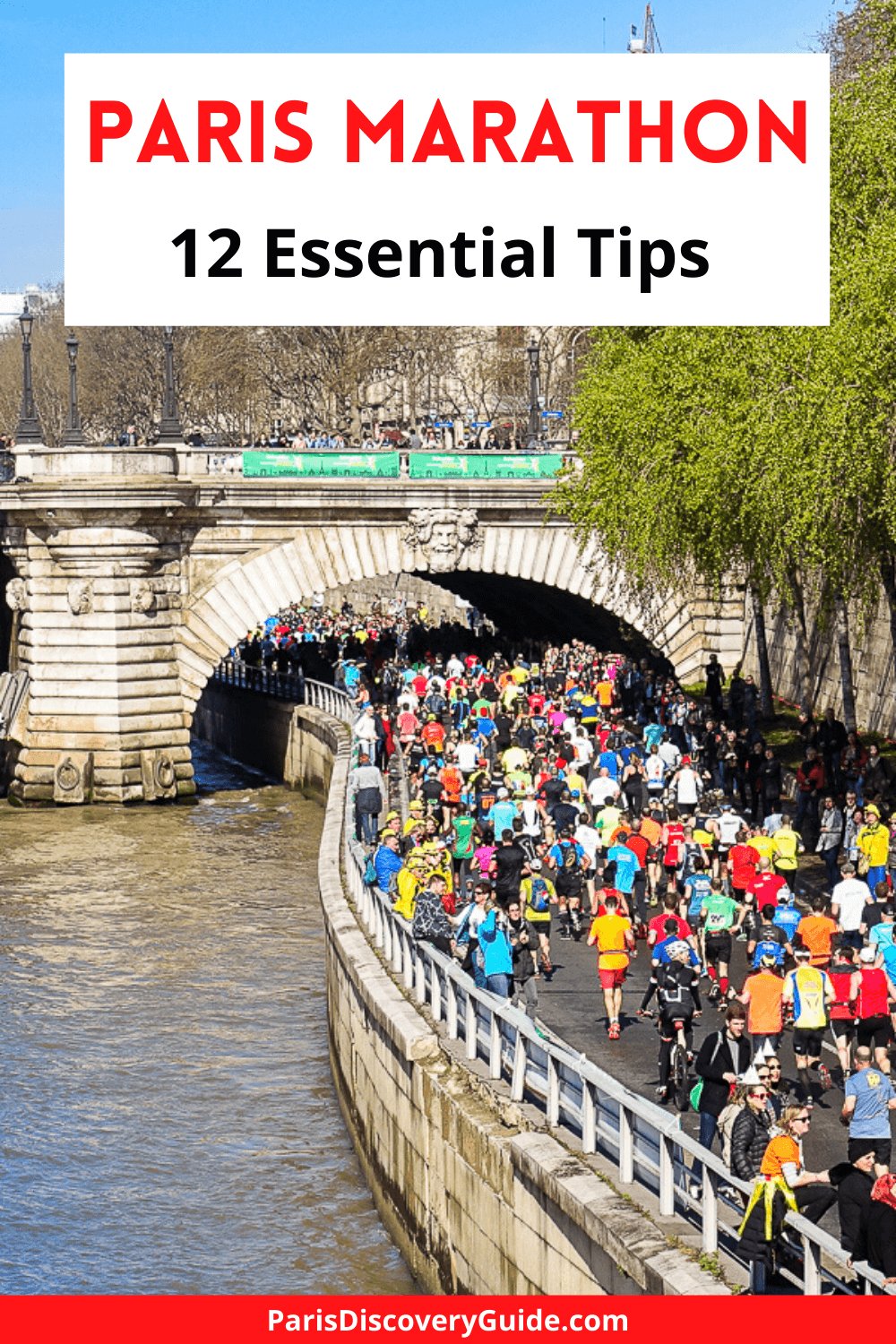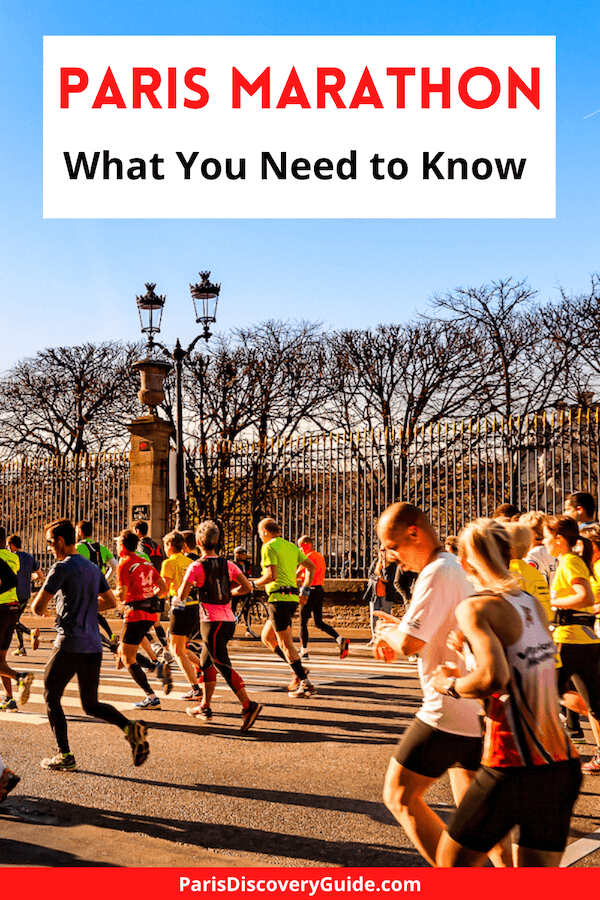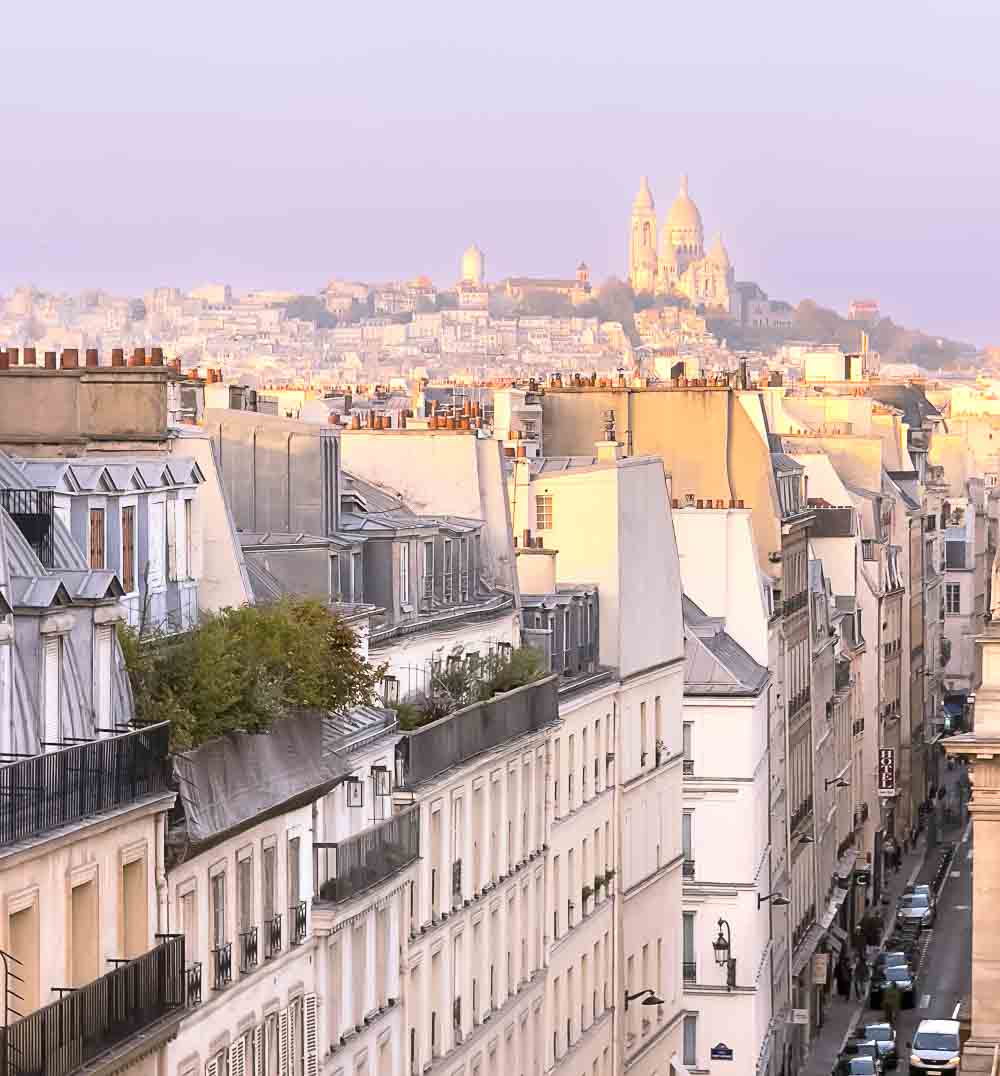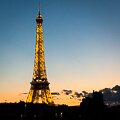The Paris Marathon (or Marathon de Paris) attracts 57,000 runners from almost 145 nations and rightly deserves its excellent reputation. Although other marathons may be larger and more prestigious, the Paris race ranks high in popularity among participants and spectators.
Not only is the Paris Marathon exceptionally well organized, but it also gives you a wonderful opportunity to discover one of the world's most beautiful cities along a mostly-flat route that takes you past gorgeous views and famous landmarks.
Plus, the event takes place each year on (usually) second Sunday in April - the perfect time to be in Paris. If that happens to coincide with Easter Sunday, then the Marathon will move to another date, such as the first Sunday in the month.
If you're among the 40% of runners and their guests visiting from abroad, or part of the 35% from outside the Paris region, allow enough time in your travel schedule to enjoy this spectacular city.
Our Paris Marathon Guide includes important tips about what runners should expect during the race and how you can make the most of your visit to Paris before and after the race.
Top photo: Paris Marathon runners next to the Seine River & Eiffel Tower, (c) Paris Discovery Guide
Paris Discovery Guide is a reader-supported publication. When you buy through my links, I may earn a small commission at no additional cost to you. Merci beaucoup for your support!
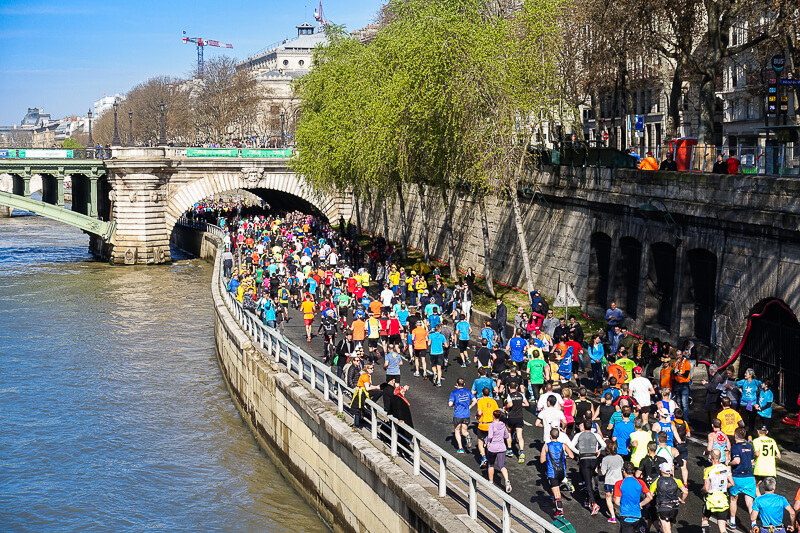
Photo courtesy of Guilhem Vellut
12 Essential Tips to Ensure the Best Paris Marathon Experience
1. Consider Jet Lag & Convenience When Planning Your Trip
If you're traveling to Paris from North America or any other distance where jet lag might kick in, do yourself a huge favor and arrive a few days or even a week before the Marathon to give your body time to adjust. Your energy and stamina levels on the day of the race will thank you!
You'll also get two secondary benefits: 1) time to explore Paris and enjoy some of its wonderful cuisine and wine, and 2) the opportunity to familarize yourself with the race course by running some or all of the route (more about the benefits of that in Tip 5).
See our recommendations for what to do while jet lagged on your first day in Paris
If you want to stay at a hotel within a short walking distance of the start/finish line near the Arc de Triomphe, be aware that they fill up quickly and may also be more expensive than other options.
Hopping on the metro (there's a station right at the Arc) and riding to your hotel may actually be easier and faster than walking any significant distance after the race. In fact, you'll see plenty of Marathon participants on the metro after the race sporting the medal and perhaps wearing some of the protective gear.
Find our Paris Marathon hotel recommendations & best areas to stay
2. Buy Your Metro Tickets Before Marathon Day
If you're planning to get to and from the Marathon on the metro, buy your tickets a day or two in advance to avoid lines at the ticket machines on the day of the race.
Although the machines are normally quick and easy to use, you don't want to be waiting behind a bunch of other exhausted Marathon visitors who can't figure how how to use them. The metro gets fairly packed throughout the afternoon after the race.
By the way, when you're on the metro heading back to your hotel after the race and your golden Marathon medal is hanging on the ribbon around your neck, it's kind of cool when the other passengers smile and say "bravo!," "salut!" and "congrats!"
3. Allow Time in Your Schedule to Pick Up Your Bib
You need to pick up your bib in person at the Marathon's "Salon du Running" at Porte de Versailles on Thursday, Friday, or Saturday before the race.
Lines will be longest on Saturday, so to save yourself time by going on one of the first two days if possible. While you're there, check out the booths and products from the 200 or so vendors who will be onsite.
Once you have your bib, hold it in front of you and take a few selfies.
4. Don't Let the Paris Marathon Course's Quirks Trip You Up (Yes, Literally)
The marathon course may be mostly flat, but it presents a few tricky obstacles and unusual surprises for the unwary:
- Fruit peels under your (running) feet - Refreshment stations offer bananas, cut oranges, and other fruit to boost your energy - which is great, except everyone throws the peels to the ground. Tread carefully or veer to the side of the course to avoid them.
- Cobblestones - Modern Paris really does not have vast numbers of cobblestone streets - but you'll encounter more than your share along the marathon course, especially early in the race. Uneven to begin with, the granite stones turn slippery and treacherous in rain, drizzle, or even fog. If the temperature drops low enough for ice to form - and it can in early April, although it's not common - watch out! Veer to avoid the cobblestone surfaces where possible, or slow your pace a bit.
- Soggy, slippery mud - If there's been any precipitation, you may encounter large patches of mud as soon as you enter the forests: Bois de Vincennes to the east of Paris, about a third of the way through the race, and Bois de Boulogne on the city's west side near the end when you're really, really tired. Navigating the slippery, sticky mud makes dealing with wet cobblestones seem easy by comparison. Be very careful, and try to run on a grassy area - but since everyone else will be doing that too, this hack doesn't help for long.
- Boredom leading to fatigue - Remember the two large wooded parks you'll run through? Yes, they're scenic and provide shade if the sun is beating down on you but after awhile, each tree looks like the next and your energy may start to lag. This is especially true on cloudy or drizzly days. Solution? Use the time to meditate, get in the zone, crank up your playlist - whatever works for you.
- Tunnels - You'll run through a series of them in a stretch along the Seine between Miles 16-18. They're actually not too long but if you're not expecting them, they can feel slightly oppressive. Plus, the upward slopes coming out of them will feel much steeper than they really are if you're not prepared for the change from the course's mostly flat terrain.
5. Make a Trial Run
Marathons are always easier when you know what to expect through experience - so do a trial run if you can. Here are three possible options, although each falls short of being ideal:
- Participate in the annual Paris Half Marathon (Semi de Paris) in March. This will give you the experience of running through the Bois de Vincennes, the large wooded park on the city's eastern edge. However, the rest of the course deviates in places from the full Marathon's route - plus at best, it's only half of it. And unless you live in Paris, making an extra visit may not be practical.
- Run along the entire 26.2 mile course a few days before the actual Marathon. This is harder than it sounds because aside from the stretches through the two large wooded parks to the east and west of Paris, you'll be dodging pedestrians and traffic in most areas, except for stretches along the Seine and the mostly car-free Rue de Rivoli, where you'll now dodge bicycles, buses, motorcycles, electric scooters emergency vehicles, taxis, and jay-walking pedestrians).
- Take advantage of the Car-Free Sundays in Paris to run the entire course, more or less vehicle-free. They take place on the first Sunday each month, so when the Marathon is scheduled for the second Sunday of April, you'd need to arrive in Paris at least 8 days before the race - a perfect excuse to enjoy extra time in the City of Light, if you're able to take that much time away from the responsibilities of your regular life.
Although the race sponsor offers a short 2+ mile "Paris Breakfast Run" on the day before the race, it follows a different route. This sprint is fun to do and you'll get close-up views of lots of famous museums and monuments, but it won't help you get familiar with the Marathon course. More information: Schneider Electric website
More Fun Ways to See Top Attractions in Paris
6. Bone Up on Kilometers
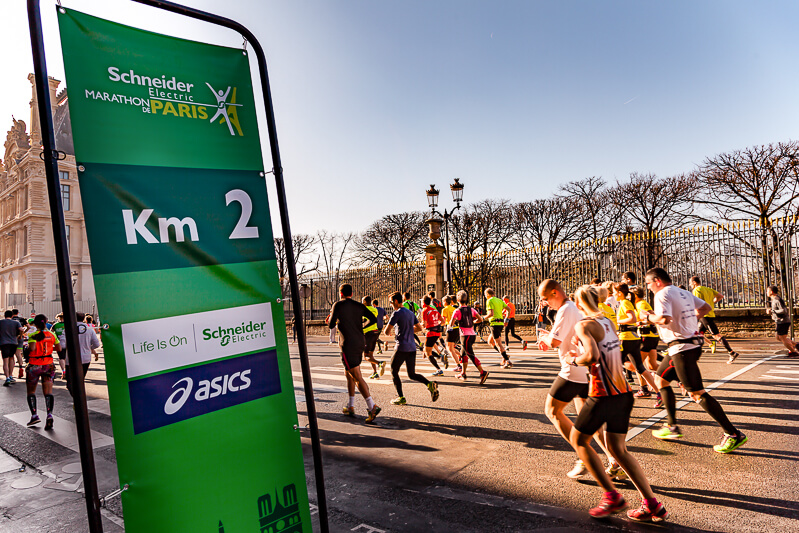
If you're from one of the few countries - primarily the United States, United Kingdom, Liberia, and Myanmar - where miles rather than kilometers are still used to measure distance, be prepared to see course markers in kilometers, and know a few basics about conversion into miles.
As a reminder: 1 kilometer = .6 mile, 1 mile = 1.6 kilometers. The official length of a marathon is 42.2 kilometers (26.2 miles)
Markers appear at 1 kilometer intevals, so if you don't want to memorize actual conversion formulas, just know that at 11km, you're slightly more than a quarter of the way, at 21km you're almost halfway done, and at 33km you've reached the three-quarters mark.
7. Remember to See the Sights Along the Paris Marathon Course
If you're running, you're about to experience perhaps the most stunningly beautiful marathon course in the world.
You'll start at the Arc de Triomphe and run down the tree-lined Champs-Élysées in the golden morning light, pass by the Eiffel Tower, Notre Dame Cathedral, Louvre, and many other famous sights, spend a couple of kilometers along the tranquil Seine River, and loop through two gorgeous (and huge) wooded parklands.
So don't forget to look around you as you're running. Consider taking photos along the way!
If you're watching the race, choose a spot where you'll have some of this stunning scenery in the background, especially if you plan to photograph the runners.
8. Should You Bring Your Own Snacks & Beverages?
You'll pass refreshment stations at 5-kilometer intervals along the route offering mostly natural and unpacked snacks and drinks: fresh fruit (orange slices, bananas, apples), dried fruit (apricots, raisins), nuts, sugar cubes, and even hard candies to suck on, along with water, other beverages, and even red wine. (Please note: while the covid pandemic continues to linger, the "communal" sliced fruit has been replaced by other options.)
However, you'll see far fewer to none of the packaged or manufactured products such the as gels, chews, and "sports drinks" common at U.S. and other marathons. If these are important to you, then yes, you should bring your favorites.
Bonus: In addition to beverages and snacks, refreshment stations also offer little sponges in pots of water for you to use to cool yourself down. (Also halted during pandemic times.)
9. Don't Believe All the Horror Stories You've Heard about Paris Marathon Toilet Facilities
Contrary to urban legends you might have heard or read about the Paris Marathon course being a toilet-free zone, you will find toilets near the starting area on Champs Elysees, near the luggage storage area on Foch Avenue, and beginning at the 5 kilometer mark, every 2.5 kilometers along the route.
If you're watching the race, you'll find these facilities handy as well.
This is not to say that runners don't relieve themselves in the wooded areas near the course as it winds through Bois de Vincennes and Bois de Boulogne - they do, as the soggy ground attests. Your feet may be happier if you don't veer from the path. Or if you do, just tell yourself that any wetness you notice is because Paris gets a lot of rain - which is true.
10. Soak up Energy from the Entertainment & Cheers Along the Route
Laser lights in the tunnels, lots of signs, brass bands, balloons, drumming bands, high-energy disco music, and entertainers make the Paris Marathon feel almost like a huge street festival.
Crowds of supporters - family, friends, and groups of Parisians - shout "allez, allez!" Soak up their energy and let it fuel you as you run by.
11. Don't Forget to Wear Sunscreen
The Marathon course provides little shade except in the short tunnels and wooded sections of the two large parks. Elsewhere, the sun reflects off the pavement and may be stronger than you might expect - so wear sunscreen.
Pack your favorite type in your suitcase, or pop into any pharmacie (marked with green neon crosses) after you arrive in Paris and look for the La Roche-Posay or Vichy brands - both make excellent sun protection products with UVA/UVB protection (look for SPF 50+) and stay on even as you sweat.
12. Flaunt Your Golden Medal (But Only for 1 Day)
The golden medal on a colorful ribbon that you'll get right after you cross the finish line near the Arc de Triomphe is gorgeous - so wear it with pride, take lots of photos with it around your neck (make sure the Arc shows in the background), and flaunt it a bit as you celebrate your race at dinner in the evening. You'll be in good company - you'll see plenty of other gold throughout the city - and you'll probably get a few more bravos from strangers.
But the next day will be just a normal Monday in Paris, so don't continue wearing it - that would seem weird. Or, if you do, keep it mostly hidden under your shirt.
See the Paris Marathon's Spirit
Feel the Marathon Day joy in this short video!
Popular Seine River Sightseeing Cruises
Hotels & Apartments Close to the Paris Marathon Route
Wondering where to stay and how to choose a hotel or apartment for the Paris Marathon? Check out our strategies and suggestions
Use this Paris hotel map to find accommodations near the Marathon route. Add your travel dates to see availability and best rates:
More about Paris in April
Pin Now, Read Again Later
More Articles about the Paris Marathon & Other April Events
- Paris Marathon Route - What you'll see and experience, mile by mile
- Paris Marathon Hotels - Find the best places to stay, whether you're running or watching
- More Top April Events in Paris - Discover more to see & do in April
- April in Paris -
- Should you buy skip-the-line tickets to Paris attractions? Yes, and here's why
- Find your way around Paris with our arrondissement map and district guide


